Are inch-thick wholesale catalogs wasteful, tree-killing doorstops or irreplaceable business tools? The answer may vary depending on who you ask, which is why many B2B wholesalers are wary of moving their catalog-based business online.
Businesses that manage complex products and high SKU counts are often skeptical that an ecommerce store can handle their B2B sales. Some may even hesitate to make the move to online selling, fearing that their customers may not be ready to make the transition to online purchasing. While these concerns are certainly valid, wholesalers that resist digitization may find themselves crowded out of their market by competitors who embrace B2B ecommerce much sooner.
In this article, we take a look at how b2b catalog in ecommerce can help boost your wholesale business and why now is the right time to go digital.
Paper Catalogs Are Good for Some Things, Bad for Others
For buyers, catalogs have their upsides and downsides. On the one hand, a paper catalog is a ready reference book that customers can familiarize themselves with. Often seen with bent pages, sticky notes, and circled products, catalogs provide a thorough overview of products.
But catalogs have their limitations. With limited space and printing resources, paper catalogs are sometimes unable to feature a complete product inventory. Navigating through tiny print with often inadequate indexes makes searching for unfamiliar items tedious. Space constraints often limit vital product information, which may cause customers to turn to a manufacturer’s catalog or go online. This can lead to a buyer finding a competitor’s website with interactive catalogs, easy inventory checks, and speedy purchase options.
Once they experience the convenience of online shopping, your customers may be less inclined to go back to calling or faxing in their catalog orders. If your business is still primarily offline, this could cause you to lose out to the rest of your competitors.
What is an Online Catalog?
An online catalog, also known as a digital catalog or B2B ecommerce catalog, is an extensive electronic catalog on a website that showcases all the products you sell and allows buyers to shop and purchase. A decade ago, bringing a catalog online might have meant posting chapters of the print catalog as PDFs. Today, B2B sellers can cater to customers with fully searchable databases of their items and new tools that dramatically improve their shopping experience.
Difference Between Online Catalogs and Paper Catalogs
Time-consuming, expensive, and complicated, physical catalogs are often outdated before the ink is dry. It’s impossible to update pricing and to add (or remove) products from an existing catalog. But, most of all, not offering a full online experience for your shoppers limits opportunities for customer education, marketing, and service.
Unlike paper catalogs, digital catalogs allow you to showcase your entire product library and make it accessible with robust search technology, shopping features, and online content. With a full online catalog, B2B online sellers can spend less time keying in orders manually and more time building relationships with their customers.
For more information on shifting to an online model and forging customer relationships, download our white paper.
How Online Catalogs Increase Your Sales
Because they are digital, online catalogs give sellers the ability to provide real-time information, automate the buying experience, and turn their entire selection of products into an effective sales and marketing tool. Online catalogs drive sales because they are accessible, convenient, and engaging.
Accessible Buying
According to Gartner, 77 percent of B2B buyers state that their latest purchase was complex or difficult. This shows how critical it is for sellers to make the research and buying experience of their products more convenient, seamless, and clear for buyers. With online catalogs, you have the opportunity to provide a spectacular product experience and remove any hesitation that buyers may have about your products.
Streamlined Shopping Experience
While elegant to look at, paper catalogs don’t have built-in buying features. Online catalogs remove friction by allowing users to research products and add any items to the cart with ease—across any device and channel—without waiting for assistance.
Engaging Content
Buyers value content, which is why many users still enjoy the experience of paper catalogs. Digital catalogs increase your customer engagement by placing your products front and center and allowing you to add elements like videos, animations, and interactive features that help modern buyers make buying decisions.



